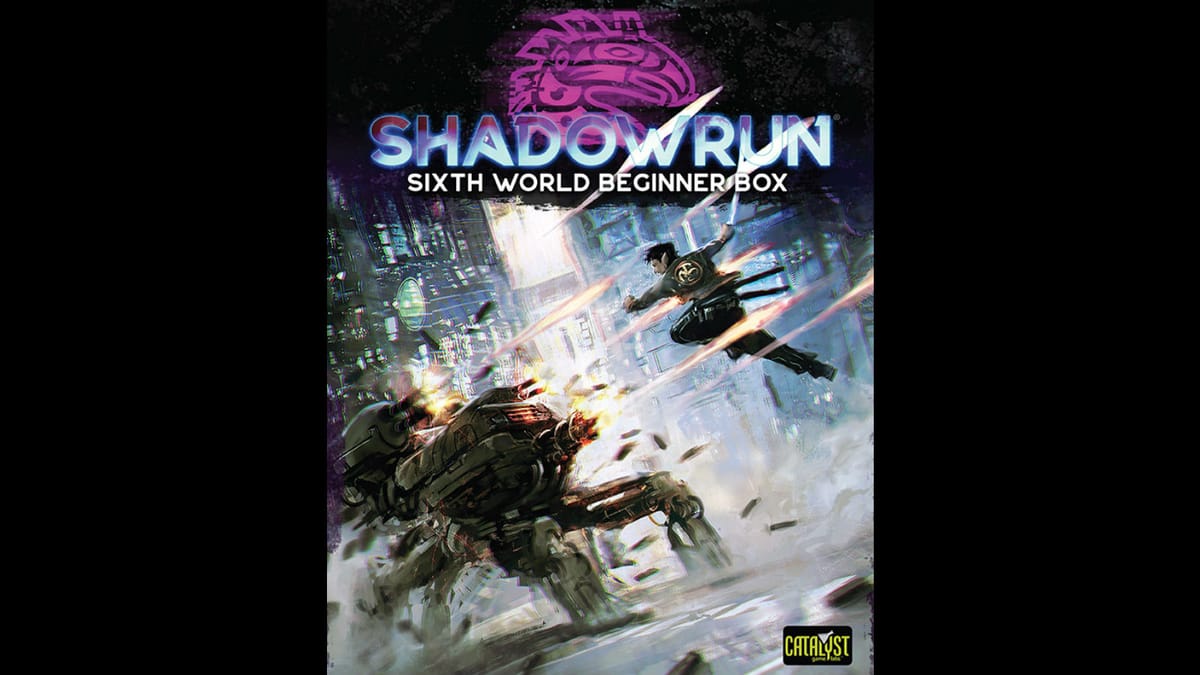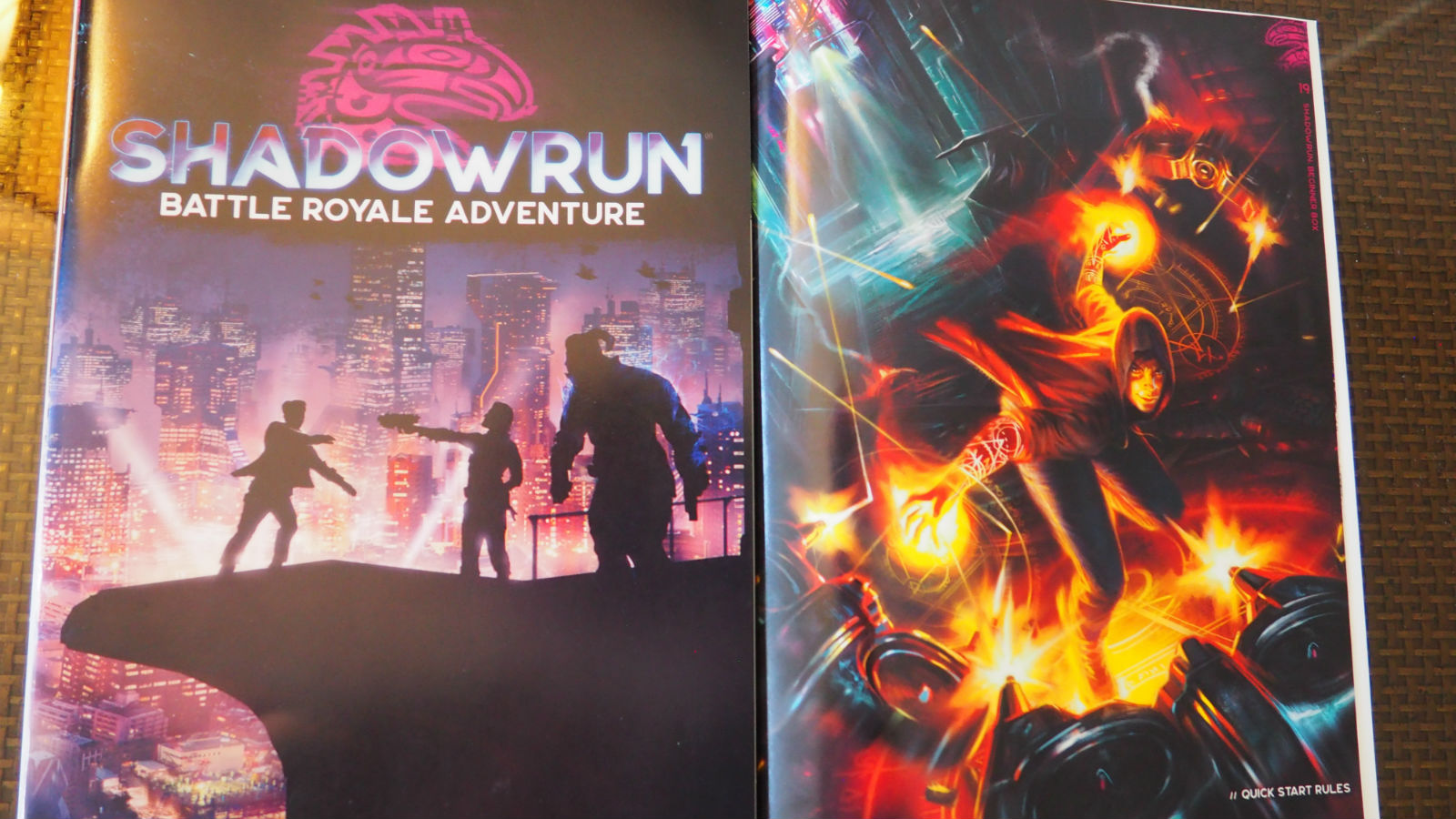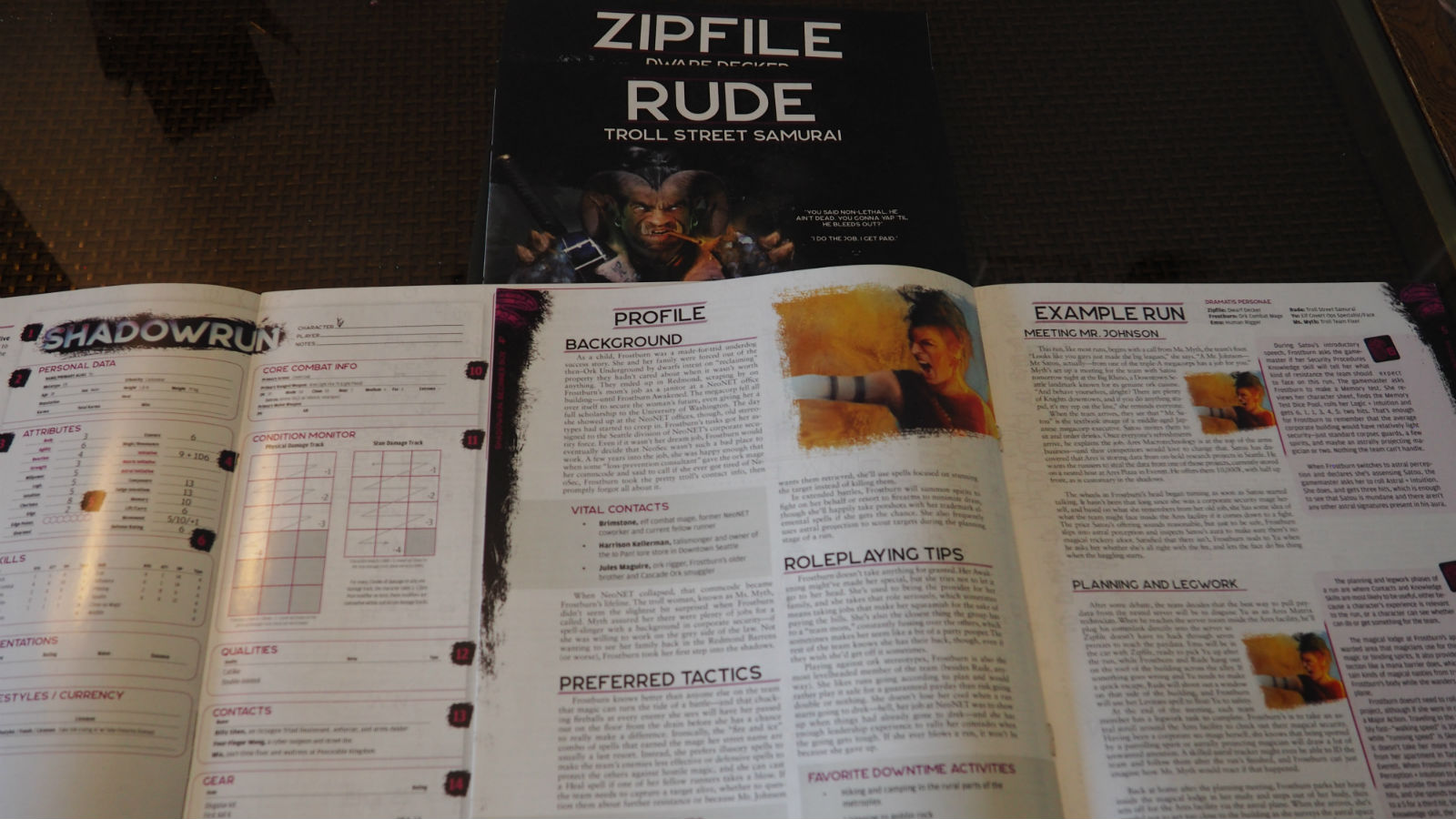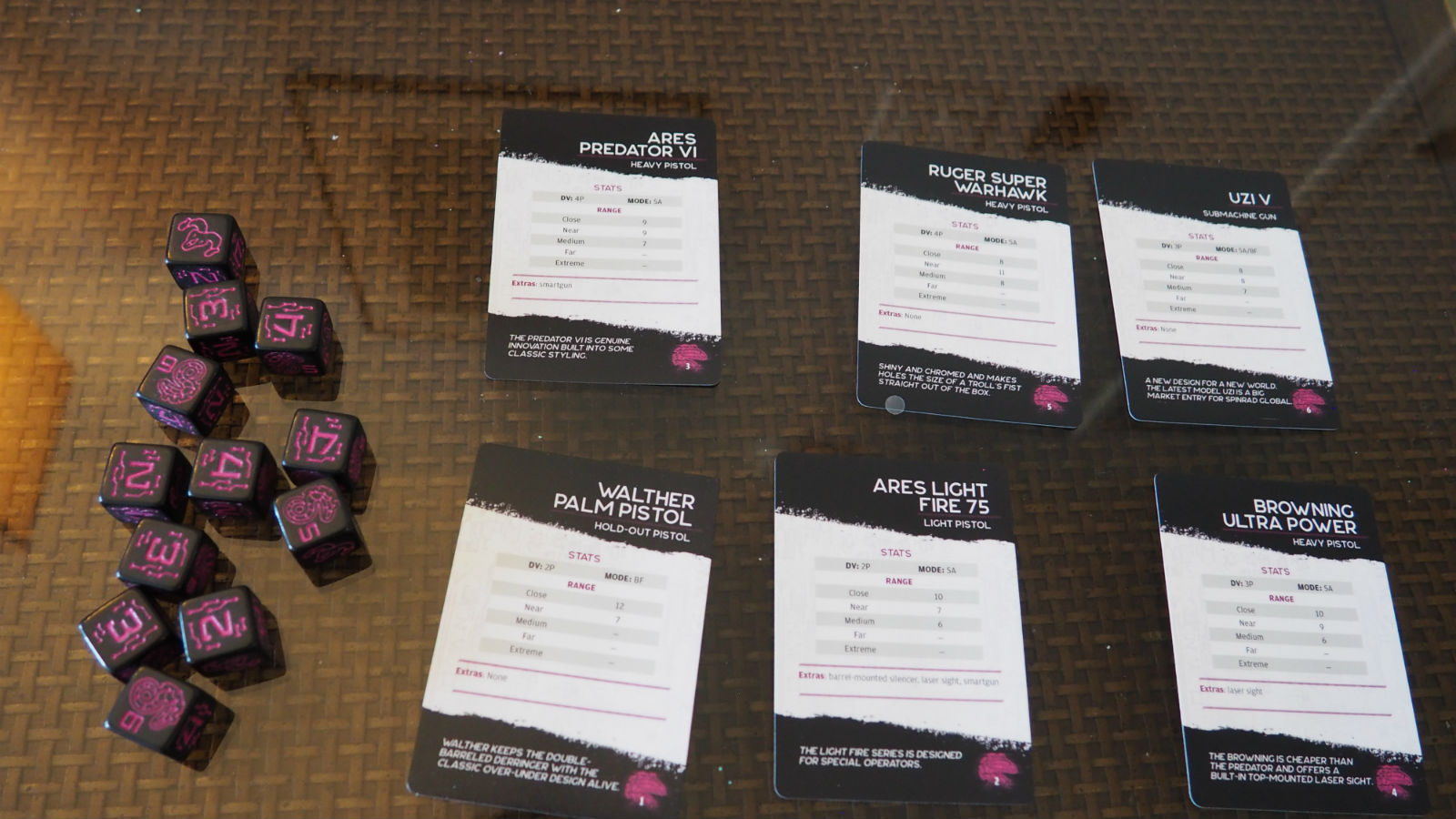
Diving into the Shadowrun Sixth World Beginner Box must feel a little bit like arriving for the first time in the futuristic version of Seattle in which the long-running roleplaying series is set. Like the dark, twisting streets of that run-down metropolis, the sixth edition of Shadowrun is built on the back of decades of byzantine structures, cluttered with the ideas of dozens of different architects and choked in its own dense history. It can make for a disorienting, inhospitable first impression, but there’s a lot to be excited about in the shadows. While the slow pace of play and novels’ worth of assumed knowledge can feel oppressive, the Sixth World Beginner Box gives you a guide capable of seeing you through the complexity to your first successful run. And ultimately, that sort of mirrors what Shadowrun is all about.
Shadowrun’s blend of fantasy and cyberpunk is certainly something of an acquired taste, and its sometimes awkward ruleset even more so, but as one of the foundational cyberpunk games, its influence can be felt all throughout gaming. It’s largely the cyberpunk setting that draws most people into Shadowrun, as its rules don’t allow for the fastest or the most mechanically interesting gameplay around, occupying sort of a middle ground that involves lots of number crunching for even simple actions. Shadowrun Sixth World seems to be an attempt to push the game into speedier, more accessible territory, perhaps to capitalize on the recent tabletop roleplaying boom that’s brought scores of potential shadowrunners into the hobby. Shadowrun is an incredibly dense game, though, both in terms of its setting and its rules, so don’t mistake “more accessible” for “approachable.”
Fortunately, the Shadowrun Sixth World Beginner Box puts in a lot of work to explain the game to neophytes. Inside the box, you’ll find four character sheets, the quick start rules guide, a pre-written adventure, a map/poster of the Seattle Metroplex, and a set of themed dice. Aside from the dice, everything here is made at least partially to get new players up to speed with the dizzying lore and rules of Shadowrun.

The first thing you’ll want to read if you’re new to the game is the four-page insert, “An Instant Guide to the Sixth World.” Somewhat confusingly, the Sixth World is both the name of the setting for Shadowrun going back to its first edition and publisher Catalyst Game Labs’ name for Shadowrun’s sixth edition, but this guide is a good starting point for both. It presents a quick overview of essentially how the world got to be so messed up and how people manage to get by regardless, centering on important concepts like magic, augmentations, and corporations, and a timeline of major events in the setting’s fiction. It’s a good primer that gives you more than enough information to get started on your first run.
To do that, you’ll need to move on to the quick start rules. In 24 pages, it runs you through the overall shape of the game and its most important concepts then dives into the nitty-gritty of combat, magic, and hacking. In short, Shadowrun Sixth World, like the editions before it, relies on a dice pool mechanic. To perform most actions in the world, you — and your opponent, if applicable — roll a number of six-sided dice determined by a relevant skill and attribute (Firearms + Agility to fire a gun, Sorcery + Magic to cast a spell). Each die that lands on five or six is a hit, and if the player hits a preset target or gets more successes than their opponent, they succeed on the roll (dealing/avoiding damage or successfully hacking a machine, for example). There are exceptions and complications, like the possibility to incur a glitch for rolling too many ones on your dice, but that basic mechanic holds true for most of the game. It’s a fun, albeit messy, system that allows for lots of ways to gain a numerical advantage. On the downside, it still drags the pace of the game down, since every action requires you to determine your dice pool, gather the necessary dice, then count up hits and misses for each charater involved.
Nearly a full page is devoted to Edge, a mechanic that’s extremely important to Shadowrun Sixth World. In this edition of the game, player characters gain Edge when they have an advantage over their opponents, either through superior stats or narrative positioning (maybe they have the drop of their enemies, know a secret exit, or have incriminating information about their opponents). They can spend Edge for special effects that usually involve dice manipulation, like buying hits or making enemies more likely to roll misses, but can also be used to heal or to gain what’s just called “creative special effect” in the guide. This is the most interesting use of Edge by far, as it essentially allows players to exercise some limited storytelling power by conjuring up some narrative occurrence that turns the battle in their favor. Edge’s importance in Sixth World is a fun addition to the formula that puts even more control into players’ hands, but it can slow the already dragging pace of combat down even further as players determine when to use Edge and which ability to use, not to mention the time spent for the Game Master to decide when to award Edge and to negotiate with players on its more creative applications. The main problem I have with it is that it’s a lot of effort spent to gain slight mechanical advantages, when it’s the underused narrative aspects of Edge that are much more exciting in actual play. The fuzzy way that Edge is awarded can also lead some players to constantly look for ways to justify getting more of it (Will this security guard be intimidated by my cyberware? I have a dog at home; can I get Edge if they’re allergic?), so I would have liked to see more guidance about what seems like the central mechanic of this edition of the rules.

Still, the quick start is remarkably thorough for such a short document, and there was nothing I encountered in playing the game that wasn’t at least somewhat explained by the quick start rules. It’s not enough to make you a Shadowrun expert, but it’s more than you’ll need to play through your first adventure. Still, the lack of context for some rules meant that I knew how to handle any given situation I came across, but couldn’t quite explain why everything worked the way it did. It’s notably lacking much of a Game Master’s guide, so if you want to tweak anything you find in the beginner box or even if the players just go off the rails during the adventure, the GM will have to handle it on their own. On the other hand, I appreciated the last few pages of the guide, which comprise a set of tables that provide a quick reference for every combat action you need, plus character stats for each of the pre-made characters that come in the box.
Each character dossier comes with a pre-filled character sheet with handy annotations to explain all the numbers and diagrams that make it up. I was particularly impressed with the amount of space devoted to each character’s background, which serves as a great jumping off point for players new to roleplaying who might not be comfortable making up their own character on the fly. Every dossier also includes a wealth of quick reference information on combat phases, important terms, and step by step guides for various actions, plus an example run that fictionalizes a few rounds of combat alongside an explanation of how it would play out behind the scenes in an actual play session. Overall, these dossiers are extremely well thought-out, it’s just that I found the characters themselves a bit boring. You get a pretty standard mage, “face” (essentially a charming rogue), street samurai brawler, and hacker (called a decker in Shadowrun parlance). It’s a diverse, well developed group, but I wish the beginner box included some guidance on tweaking your characters. It doesn’t explain character customization at all, which makes sense since that won’t happen in the included adventure, but it would have been a nice touch to add some longevity.
The adventure itself is the element I was most disappointed with. It follows the “food fight” setup that’s sort of a cross between a tradition and a self-referential joke for the initial pre-written adventure of each edition of Shadowrun. Modeled loosely after the adventure included with the first edition of Shadowrun, the food fight-style adventure has the party minding their own business as they try to buy some fast food when they’re forced to deal with an aggressive threat. In the Sixth World Beginner Box, that adventure is Battle Royale, which sees the party dragged into a fight against an armed gang that eventually turns into a rescue mission for an important government official. It’s a perfectly fine generic RPG setup, but the food fight formula has just never suited Shadowrun very well. Shadowrun is a game about a group of downtrodden freelancers scraping by on jobs tossed to them by backstabbing corporations, striking out at the forces that keep them oppressed before slinking home to the slums. The impromptu “let’s go save the day” structure of Battle Royale just doesn’t feel like an actual Shadowrun campaign does, so it doesn’t feel like the best introduction. Picky thematic issues aside, Battle Royale is a functional but not particularly interesting adventure, and it seems a little barebones for a first-time group. Experienced players likely won’t have any trouble, but it seems to demand a lot of buy-in from the players inhabiting their characters to even accept the call to action. There are also a lot of narrative gaps for new GMs to fill in, despite the handy mix of verbatim descriptions to read aloud and background info for GMs to keep in their back pocket.

One of the hardest problems to overlook in the Sixth World Beginner Box is the prevalence of errors in the text. These range from typos, which are annoying but ultimately ignorable, to outright incorrect gear cards that include descriptions for the wrong spells. The wording of some descriptions can also be ambiguous, and without a full rulebook to defer to, it’s often up to players to just decide what sounds most reasonable to them. In a game that’s already as slow-paced as Shadowrun, it can force play to a complete halt as players try to figure out which version of a rule is right or what the book is trying to say. Especially in a product that’s explicitly meant for beginners, these errors can lead to a lot of confusion, though they don’t make the game unplayable.
Overall, the Shadowrun Sixth World Beginner Box is a solid introduction to the long-running RPG’s latest edition, but one that’s hard to recommend. Though it does a good job of explaining the very basics of Shadowrun’s setting, that information is all easily accessible online for anyone interested and extraneous for anyone who’s familiar with the game. The guides included give you everything you need to run through the included adventure, but after I played it, I still didn’t feel like I really understood Shadowrun Sixth World as a whole. I certainly don’t feel equipped to run a game or create my own character, and the Battle Royale adventure doesn’t feel like any actual campaign of Shadowrun I’ve ever heard of. Combined with the multitude of printing errors, that feeling that the beginner box is only a self-contained demo of Shadowrun rather than an introduction to the larger game calls its usefulness into question. That’s not a criticism of Shadowrun Sixth World as a whole, which seems like an interesting step forward for the game if nothing else. In a way, the beginner box did exactly what I imagine Catalyst wanted it to, which is make me want to buy the core rulebook. I just wish it did so by being so good that I couldn’t wait for more rather than feeling like a watered-down version of something potentially great.
Shadowrun: Sixth World Beginner Box
All Right
The Shadowrun Sixth World Beginner Box does a good job situating players in Shadowrun’s world and sending them on their first run, but feels like an unnecessary half-step into the game. While the quick start rules and character dossier pack a wealth of information into a short length, the included adventure is lackluster and a poor introduction to an actual Shadowrun campaign, and they’re all replete with errors in the text. The Shadowrun Sixth World Beginner Box ultimately feels like a competent but skippable introduction to the game.
Pros
- Faster-paced, modernized ruleset
- Decent introduction to Shadowrun’s world and mechanics
- Character dossiers are detailed and easy to use even for newcomers
Cons
- No information on character customization
- Lots of typos, ambiguous wording, and errors in the text
- Underwhelming pre-written adventure
- Quick start rules leave too much unexplained or open to interpretation for new players
